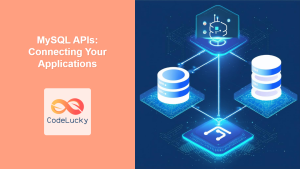In today’s interconnected digital landscape, the ability to integrate third-party services into your PHP applications is a crucial skill for any developer. APIs (Application Programming Interfaces) serve as the bridge between different software systems, allowing them to communicate and share data seamlessly. This article will dive deep into the world of PHP and APIs, exploring how to effectively integrate various third-party services into your PHP projects.
Understanding APIs and Their Importance
APIs are sets of protocols, routines, and tools that specify how software components should interact. They act as intermediaries, allowing different applications to communicate with each other, share data, and perform actions without the need for direct access to each other’s code base.
🔑 Key Benefits of Using APIs:
- Enhanced functionality without reinventing the wheel
- Access to specialized services and data
- Improved efficiency and reduced development time
- Scalability and flexibility in application design
Making API Requests with PHP
PHP offers several methods to make API requests. Let’s explore some of the most common approaches:
1. Using cURL
cURL (Client URL) is a library that allows you to make HTTP requests in PHP. It’s versatile and widely used for API interactions.
Here’s a basic example of how to use cURL to make a GET request to a hypothetical weather API:
<?php
// Initialize cURL session
$ch = curl_init();
// Set the URL
curl_setopt($ch, CURLOPT_URL, "https://api.weatherservice.com/current?city=NewYork");
// Set option to return the response as a string
curl_setopt($ch, CURLOPT_RETURNTRANSFER, true);
// Execute the request and get the response
$response = curl_exec($ch);
// Check for errors
if(curl_errno($ch)){
echo 'cURL Error: ' . curl_error($ch);
}
// Close cURL session
curl_close($ch);
// Process the response (assuming it's JSON)
$data = json_decode($response, true);
// Display the temperature
echo "Current temperature in New York: " . $data['temperature'] . "°C";
?>
In this example, we’re making a GET request to a weather API to fetch the current temperature in New York. Let’s break down the steps:
- We initialize a cURL session with
curl_init(). - We set the URL for the API endpoint using
curl_setopt(). - We set an option to return the response as a string.
- We execute the request with
curl_exec()and store the response. - We check for any cURL errors.
- We close the cURL session.
- We decode the JSON response and extract the temperature data.
🔍 Pro Tip: Always check the API documentation for the correct endpoint URL, required parameters, and response format.
2. Using file_get_contents()
For simpler GET requests, PHP’s file_get_contents() function can be used. It’s less flexible than cURL but easier to use for basic scenarios.
<?php
$url = "https://api.quotesservice.com/random";
$response = file_get_contents($url);
if ($response === false) {
echo "Failed to get contents from the API";
} else {
$data = json_decode($response, true);
echo "Random Quote: " . $data['quote'];
}
?>
This example fetches a random quote from a hypothetical quotes API. It’s straightforward but lacks the advanced options that cURL provides.
3. Using Guzzle HTTP Client
Guzzle is a popular PHP HTTP client that makes it easy to send HTTP requests and integrate with web services. First, you need to install Guzzle using Composer:
composer require guzzlehttp/guzzle
Here’s an example of using Guzzle to make a POST request to a hypothetical user registration API:
<?php
require 'vendor/autoload.php';
use GuzzleHttp\Client;
use GuzzleHttp\Exception\RequestException;
$client = new Client();
try {
$response = $client->post('https://api.userservice.com/register', [
'json' => [
'username' => 'newuser123',
'email' => '[email protected]',
'password' => 'securepassword'
]
]);
$body = $response->getBody();
$data = json_decode($body, true);
echo "User registered successfully. User ID: " . $data['user_id'];
} catch (RequestException $e) {
echo "Error: " . $e->getMessage();
}
?>
In this example:
- We create a new Guzzle client.
- We make a POST request to the registration endpoint, sending JSON data in the request body.
- We handle the response and potential exceptions.
Guzzle provides a more object-oriented approach and handles many low-level details for you.
Handling API Authentication
Many APIs require authentication to ensure secure access. Let’s look at some common authentication methods:
API Key Authentication
Some APIs use a simple API key for authentication. You typically include this key in your request headers or as a query parameter.
<?php
$apiKey = "your_api_key_here";
$ch = curl_init();
curl_setopt($ch, CURLOPT_URL, "https://api.service.com/data");
curl_setopt($ch, CURLOPT_RETURNTRANSFER, true);
curl_setopt($ch, CURLOPT_HTTPHEADER, [
"Authorization: Bearer $apiKey",
"Content-Type: application/json"
]);
$response = curl_exec($ch);
curl_close($ch);
// Process the response...
?>
OAuth 2.0 Authentication
OAuth 2.0 is a more complex but secure authentication protocol. Here’s a basic example of how you might use it with PHP:
<?php
$clientId = "your_client_id";
$clientSecret = "your_client_secret";
$redirectUri = "https://your-app.com/callback";
// Step 1: Redirect user to authorization URL
$authUrl = "https://api.service.com/oauth2/authorize?client_id=$clientId&redirect_uri=$redirectUri&response_type=code";
// Redirect user to $authUrl
// Step 2: Exchange authorization code for access token
if (isset($_GET['code'])) {
$code = $_GET['code'];
$tokenUrl = "https://api.service.com/oauth2/token";
$postData = [
'grant_type' => 'authorization_code',
'code' => $code,
'redirect_uri' => $redirectUri,
'client_id' => $clientId,
'client_secret' => $clientSecret
];
$ch = curl_init($tokenUrl);
curl_setopt($ch, CURLOPT_RETURNTRANSFER, true);
curl_setopt($ch, CURLOPT_POSTFIELDS, http_build_query($postData));
$response = curl_exec($ch);
curl_close($ch);
$tokenData = json_decode($response, true);
$accessToken = $tokenData['access_token'];
// Use $accessToken for subsequent API requests
}
?>
This is a simplified OAuth 2.0 flow. In practice, you’d want to securely store the access token and refresh it when necessary.
Parsing API Responses
Most modern APIs return data in JSON format. PHP provides built-in functions to work with JSON:
<?php
$jsonString = '{"name": "John Doe", "age": 30, "city": "New York"}';
// Decoding JSON to PHP array
$data = json_decode($jsonString, true);
echo "Name: " . $data['name'] . ", Age: " . $data['age'];
// Encoding PHP array to JSON
$phpArray = ['fruit' => 'apple', 'color' => 'red'];
$jsonOutput = json_encode($phpArray);
echo $jsonOutput; // {"fruit":"apple","color":"red"}
?>
Error Handling and Rate Limiting
When working with APIs, it’s crucial to implement proper error handling and respect rate limits.
Error Handling
Always check for and handle potential errors in API responses:
<?php
$ch = curl_init("https://api.example.com/data");
curl_setopt($ch, CURLOPT_RETURNTRANSFER, true);
$response = curl_exec($ch);
if(curl_errno($ch)) {
echo "cURL Error: " . curl_error($ch);
} else {
$httpCode = curl_getinfo($ch, CURLINFO_HTTP_CODE);
if($httpCode == 200) {
// Process successful response
$data = json_decode($response, true);
// Use $data...
} else {
echo "API Error: HTTP Code $httpCode";
// Handle error based on HTTP code
}
}
curl_close($ch);
?>
Rate Limiting
Respect the API’s rate limits to avoid being blocked. Implement a delay between requests if necessary:
<?php
function makeApiRequest($url) {
static $lastRequestTime = 0;
$minTimeBetweenRequests = 1; // 1 second
$currentTime = microtime(true);
if ($currentTime - $lastRequestTime < $minTimeBetweenRequests) {
usleep(($minTimeBetweenRequests - ($currentTime - $lastRequestTime)) * 1000000);
}
$ch = curl_init($url);
curl_setopt($ch, CURLOPT_RETURNTRANSFER, true);
$response = curl_exec($ch);
curl_close($ch);
$lastRequestTime = microtime(true);
return $response;
}
// Usage
$response1 = makeApiRequest("https://api.example.com/endpoint1");
$response2 = makeApiRequest("https://api.example.com/endpoint2");
// These requests will be at least 1 second apart
?>
Real-World Example: Integrating with GitHub API
Let’s put everything together with a real-world example using the GitHub API to fetch repository information:
<?php
function getGitHubRepoInfo($owner, $repo) {
$url = "https://api.github.com/repos/$owner/$repo";
$ch = curl_init($url);
curl_setopt($ch, CURLOPT_RETURNTRANSFER, true);
curl_setopt($ch, CURLOPT_USERAGENT, 'PHP GitHub API Client');
$response = curl_exec($ch);
if(curl_errno($ch)) {
throw new Exception(curl_error($ch));
}
$httpCode = curl_getinfo($ch, CURLINFO_HTTP_CODE);
curl_close($ch);
if($httpCode !== 200) {
throw new Exception("GitHub API Error: HTTP Code $httpCode");
}
return json_decode($response, true);
}
try {
$repoInfo = getGitHubRepoInfo('php', 'php-src');
echo "Repository: " . $repoInfo['full_name'] . "\n";
echo "Description: " . $repoInfo['description'] . "\n";
echo "Stars: " . $repoInfo['stargazers_count'] . "\n";
echo "Forks: " . $repoInfo['forks_count'] . "\n";
echo "Open Issues: " . $repoInfo['open_issues_count'] . "\n";
} catch (Exception $e) {
echo "Error: " . $e->getMessage();
}
?>
This script fetches information about the PHP source code repository on GitHub. Here’s what it does:
- Defines a function
getGitHubRepoInfothat makes a GET request to the GitHub API. - Sets a user agent, which is required by the GitHub API.
- Checks for cURL errors and non-200 HTTP status codes.
- Decodes the JSON response into a PHP array.
- In the
tryblock, it calls the function and prints out various pieces of information about the repository. - Catches and displays any exceptions that might occur during the process.
Conclusion
Integrating third-party services via APIs is a powerful way to extend the functionality of your PHP applications. By mastering the techniques covered in this article – from making API requests and handling authentication to parsing responses and managing errors – you’ll be well-equipped to leverage the vast ecosystem of web services available today.
Remember, when working with APIs:
- Always refer to the API’s documentation for specific requirements and best practices.
- Implement proper error handling and respect rate limits.
- Secure your API keys and tokens, especially in production environments.
- Consider using PHP libraries like Guzzle for more complex API interactions.
As you continue to explore the world of APIs, you’ll find that they open up endless possibilities for creating rich, data-driven PHP applications. Happy coding! 🚀💻



















